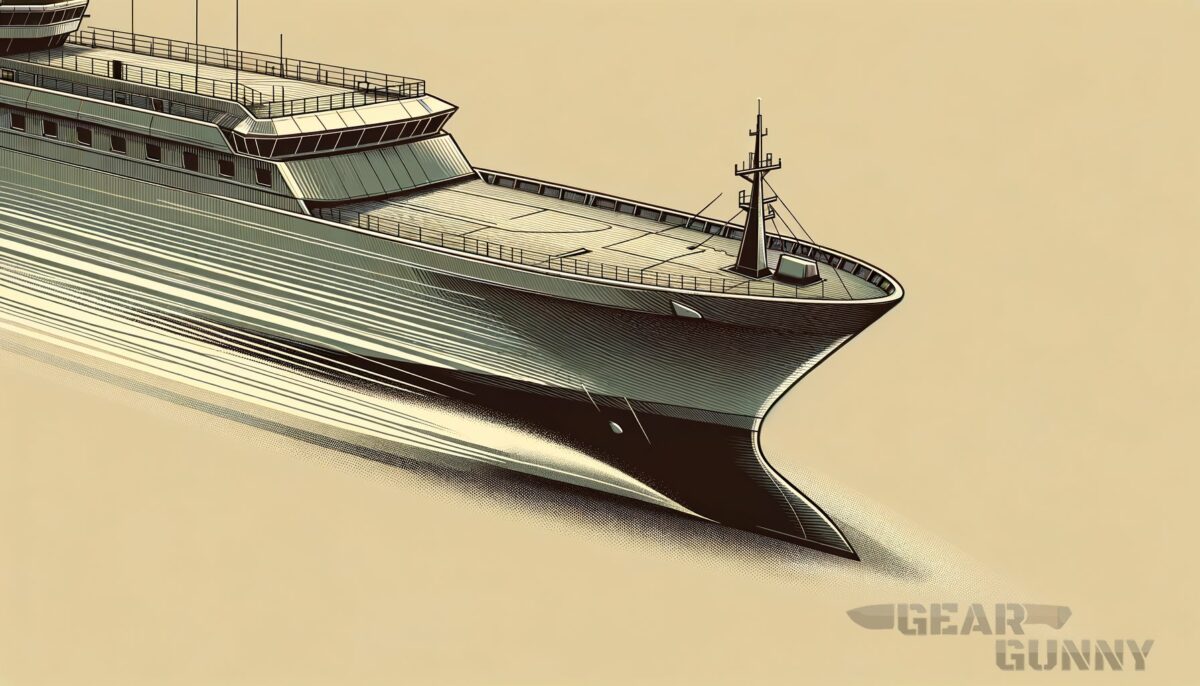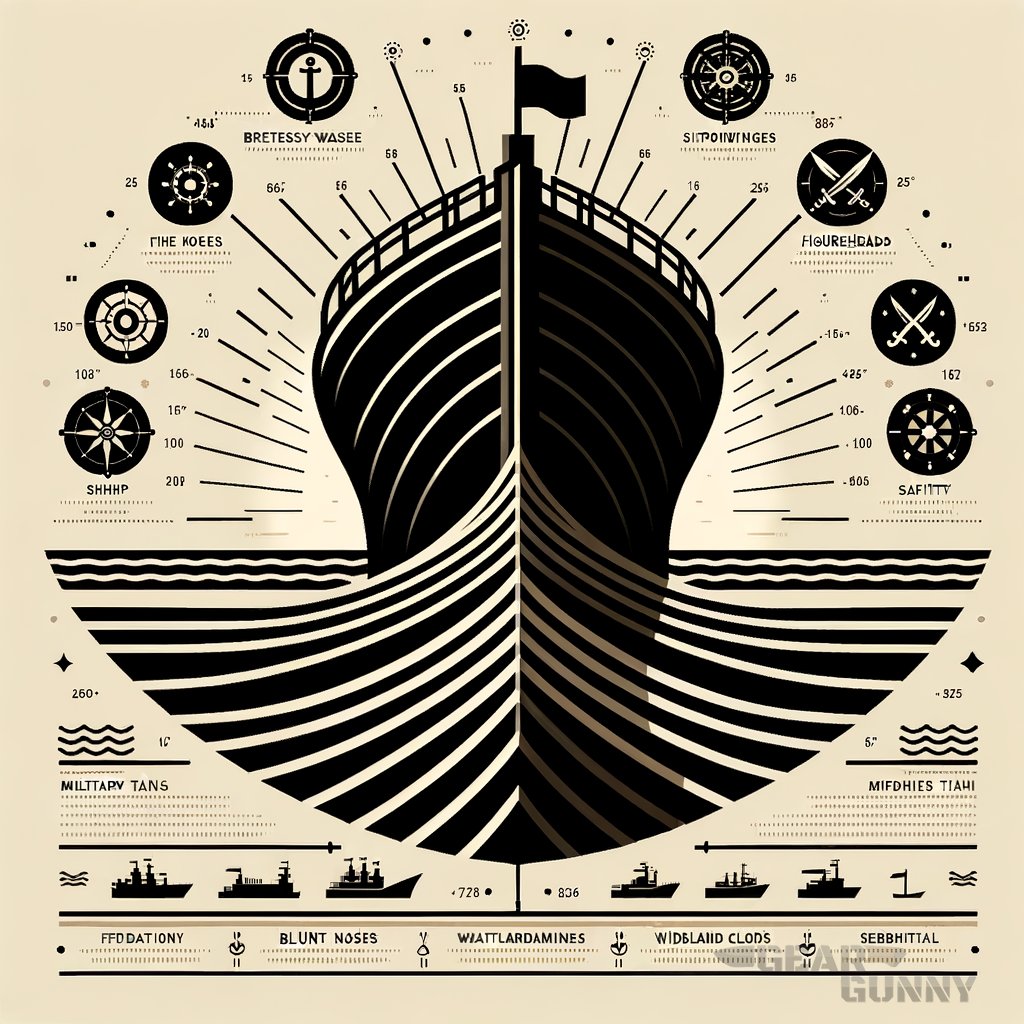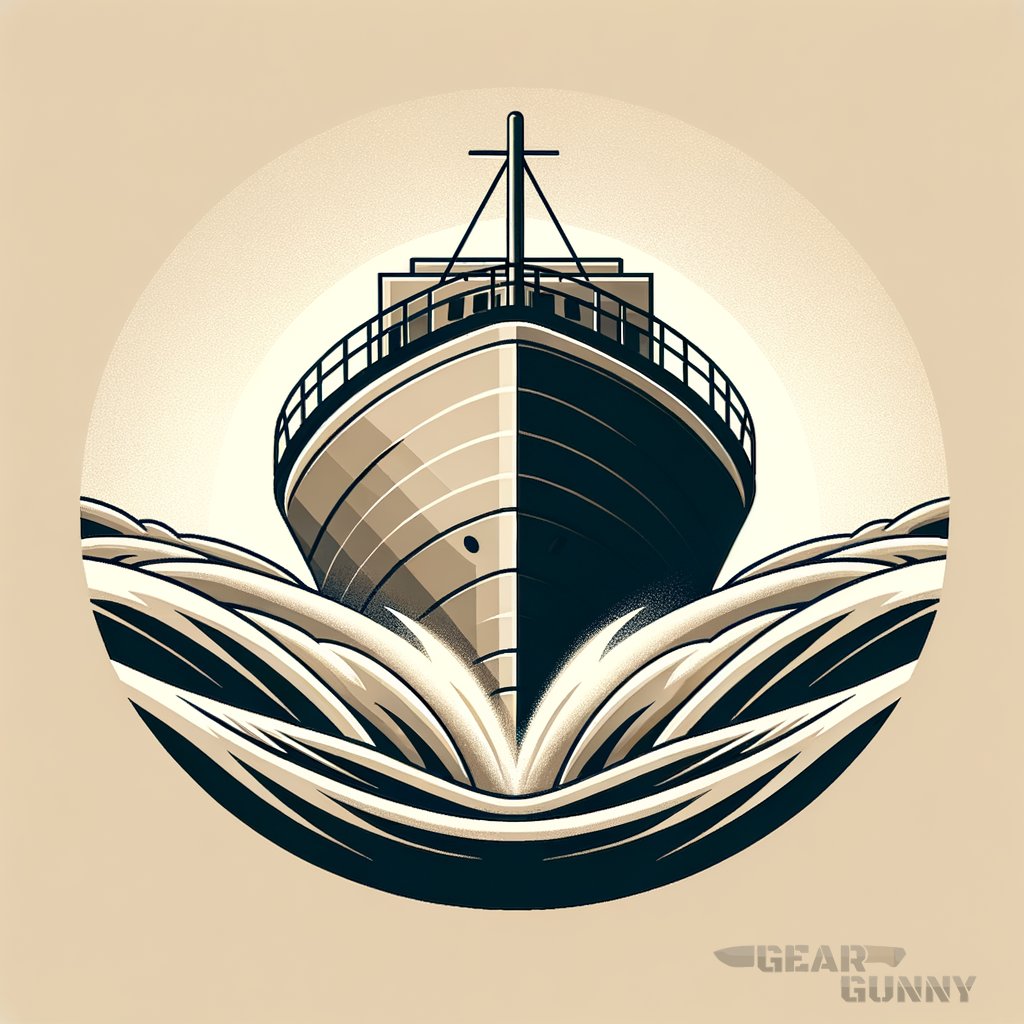Ever wondered while gearing up in a tactical plate carrier how different aspects of strategy and design come into play beyond the battlefield? Let’s dive into the world of maritime design and explore one such element. What is the Bow of a ship?
We’ll uncover what it is and why it’s crucial in naval architecture.
What is the Bow of a ship?
The bow of a ship is its frontmost part, cutting through water as the vessel advances. It’s designed to minimize resistance and wave-making, ensuring smooth sailing.

- Function: The bow’s function is crucial; it breaks waves and provides stability. Navigating through rough seas, the bow’s form can make a significant difference in a ship’s handling and speed. It enables efficient travel by reducing the effort needed to move forward.
- Shape: Over time, the design has evolved from blunt noses on ancient vessels to the sleek, bulbous bows on modern ships. This transformation showcases the continuous innovation in maritime technology.
- History: Historically, bows were usually adorned with figureheads – carved wooden decorations symbolizing the ship’s spirit. While mostly ornamental today, these figureheads were once thought to offer protection and good luck on treacherous voyages.
The bow isn’t just a structural component; it’s integral to a ship’s performance, and its artful design is a testament to maritime craftsmanship. To navigate through the details of cutting-edge gear used today, check out the best plate carriers for top-notch maritime operations efficiency.
My take on the bow of a ship? It’s like the tip of a spear in a warrior’s hand, an essential part of any tactical approach, whether on land or at sea. It’s far from my regular beat, but the strategic significance of design in marine and military gear isn’t lost on me.
I recall a buddy’s tale, a Navy man, who said hitting rough waters without a properly designed bow was like going into a hot zone without your armor secured – unadvisable and, frankly, a bit daft. We’ve seen this play out in epic sea battle scenes in movies like “Master and Commander,” where the bow slices the ocean like a knife, showcasing its importance in real-time tactics. For a look at the equally crucial gear used in battle, take a gander at the tactical gloves designed for combat and survival.
5.11 Rush 24 Tactical Backpack

5.11 Rush 24 Tactical Backpack
Importance of the bow
The bow of a ship is its foremost point, setting the stage for the vessel’s movement and efficiency in water. Crucial for reducing drag, the bow cuts through the ocean, allowing ships to move with ease.
- Impact on vessel performance: Just as crucial gear like tactical belts is for a mission, the bow’s shape dramatically impacts maritime operations. A well-designed bow leads to reduced fuel consumption, higher speeds, and improved stability in various sea conditions.
- Evolution of the bow design: From the ornamented prows of ancient galleys to the innovative bulbous bows of modern freighters, the bow’s design has continuously evolved, reflecting technological advancements in maritime engineering.
The bow is a masterpiece of naval architecture, a pivot point that balances art and efficiency on the high seas. For the gear that helps you maintain your tactical edge on land, be sure to check out the best tactical boots.
“The bow of a ship is its foremost point, setting the stage for the vessel’s movement and efficiency in water. It’s a pivot point that balances art and efficiency on the high seas, integral to a ship’s performance and its artful design is a testament to maritime craftsmanship.”
Different bow designs
Bows come in various shapes, each tailored to the ship’s intended use and the waters it will navigate.

- Flared bow: Known for pushing water aside, flared bows offer enhanced buoyancy and dryness. You won’t find too many tactical advantages here, unlike when you’re selecting from the best knives for field use.
- Bulbous bow: Usually found on large vessels, the bulb extends below the waterline, altering the wave pattern and reducing drag much like how backface signature in armor testing ensures maximum protection.
Every bow’s design has a purpose, targeting specific needs for the vessel’s role at sea just as Barnyard acid-resistant leather targets durability in tough conditions.
Bow terminology
The language of the bow includes terms that refine our understanding of its parts and purposes.
- Prow: The forward-most part of a ship’s bow.
- Stem: The leading edge of the bow, where the hull’s sides meet at the front.
- Forepeak: The compartment located at the very front of the bow, usually used for storing gear or as a crew space.
The bow’s vocabulary reflects the precision and adaptability required for maritime success—an echo of how military lingo like “battlefield airmen” captures the essence of specialized roles within the AFSOC.
Advanced maritime technology plays a pivotal role in the functionality of a ship’s bow.
- Sonar: Just as a Blue Force tracker keeps you aware of friendlies, sonar systems help navigate waters ahead of the bow.
- Icebreaking capabilities: Some bows are reinforced to break through ice, forging a path in the frozen expanses just as a USMC machine gunner might clear a path for their squad.
Adding technology into the bow’s design is key to expanding a ship’s capabilities, akin to how an ASK kit enhances armor survivability.
Cultural and historical significance of ship bows
The bow holds cultural significance, usually symbolized in art and history.
- Figureheads: These intricately carved pieces found on older ship bows served as talismans and status symbols, a far cry from the functional utility of BDU (Battle Dress Uniform).
- Naming ceremonies: The practice of christening and naming ships has always centered around the bow, imbuing it with an almost sacred status, reminiscent of time-honored military traditions.
The bow’s cultural impact is rich and diverse, weaving together stories of exploration, warfare, and mythology.
Summary of the significance of ship bows
Bows are essential for optimal maritime operations, much like tactical gear is for military efficacy. They are thoughtfully engineered to slice through water, minimize drag, and ensure smooth sailing.
The significance of ship bows
| Function | Benefit | Example |
|---|---|---|
| Wave-breaking | Reduces resistance | Ancient triremes |
| Streamlining | Speed and fuel efficiency | Modern cargo ships |
| Aesthetic | Cultural symbolism | Viking longships |
Functionality and symbolism march in tandem across the bow’s history, prompting us to respect its role — much like we honor the tools and technologies that underpin our safety and success in any tactical endeavor.
More bow design tips
When it comes to optimizing the bow design of a ship, the details make all the difference—akin to how fine-tuning your loadout with the best plate carriers can affect mission outcome. Here’s how you can ensure your ship’s bow is up to snuff.
- Consider the ship’s intended purpose to choose the right bow type.
- Study different water environments and how wave patterns might affect the bow.
- Research historical and modern bow designs for a well-informed strategy.
- Consult with marine engineers to incorporate advanced technology like hydrodynamics.
- Regularly maintain the bow to preserve its effectiveness and longevity.
Leading into the gist of bow design, keep in mind there’s a balance between form and function, dos and don’ts that’ll steer you right.
Dos and don’ts of bow design
| Do | Don’t |
|---|---|
| Opt for a bow shape suited to expected sea conditions | Neglect the impact of environmental pressures |
| Integrate advanced materials for durability | Skimp on quality for a lower upfront cost |
| Ensure compatibility with navigation technology | Ignore advancements in maritime technology |
| Create a bow that complements the ship’s overall design | Compromise on aesthetics completely |

Advantages and disadvantages of bow designs
Various bow designs come with their sets of pros and cons, similar to how your tactical gear has to be chosen based on the mission’s demands.
Advantages
- Improved fuel efficiency reduces operational costs.
- Enhanced speed for quicker voyages.
- Better stability in rough weather increases safety.
- Innovative designs can minimize environmental impact.
Disadvantages
- Some designs may increase construction costs.
- Specialized designs might not be as effective in different sea conditions.
- Regular maintenance is required to keep the bow in peak condition.
- A poorly designed bow can severely affect a ship’s performance.
Weighing the advantages and disadvantages of bow designs is a tactical decision much like choosing anything from a loadout, where everything must serve a strategic purpose.
If you are a visual learner, check out this video titled ‘Why Are Bows That Shape?’
Frequently asked questions (FAQ)
What materials are used in the construction of a ship’s bow?
Modern ship bows are typically constructed using steel that is both high-strength and resistant to corrosion. For ships designed for specific tasks, such as icebreakers, harder materials that can withstand repeated impact with ice are used. The choice of material is crucial for the durability and functionality of the bow.
How does the design of a ship’s bow affect its speed?
The design of a ship’s bow directly impacts its hydrodynamic efficiency, which in turn affects speed. A well-designed bow, like the bulbous bow, can reduce the drag caused by water resistance, allowing the ship to move faster. It alters the wave patterns around the ship, which can lead to significant fuel savings and increased velocities.
Are there any regulations governing the design of ship bows?
Yes, there are international regulations that govern not only the safety aspects of bow design but also environmental regulations aimed at reducing the ecological impact of ships. These include the International Convention for the Safety of Life at Sea (SOLAS) and regulations put forth by the International Maritime Organization (IMO), which set standards for the construction of bows and overall ship design.
Final thoughts
In the maritime world, the bow is more than just a part of a ship; it’s a fundamental element that blends scientific ingenuity with historical significance. Optimizing the bow is akin to fine-tuning tactical gear; it requires attention to detail and a deep understanding of the environment it will face. Through this exploration, we’ve learned how the bow’s design directly impacts a ship’s functionality and performance at sea.
What’s your take on the importance of precise design in marine architecture and its parallels with military strategy? Did I cover everything you wanted to know? Let me know in the comments section below I read and reply to every comment.
If you found this article helpful, share it with a friend, and check out my full blog for more tips and tricks on maritime design. Thanks for reading and stay sharp out there, both on land and sea.
- The bow of a ship is the front part that cuts through water, shaping its efficiency and speed.
- Design variations like the bulbous bow are tailored to specific maritime needs, balancing form and function.
- Optimizing a ship’s bow is crucial, much like selecting the right tactical gear for a mission’s success.















